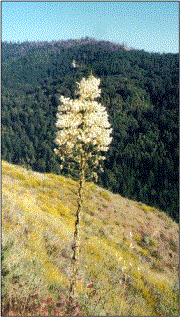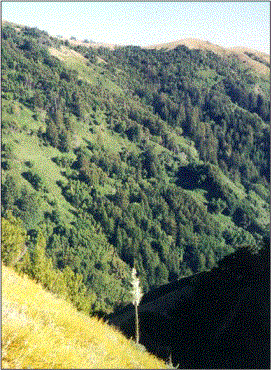PART
FIVE
moth emerges and
goes to work
|
with the warm spring rains the yucca whipplei
blooms
the yucca moth tegeticula maculata emerges
from the ground and breaks out of the cocoon
it is ready
to conduct such a refined devoted act of reproduction
in such a singular testimony to mutual need
that it must be love
it immediately looks for yucca flower
first the male must fertilize the female
so they fly together to a yucca flower
crawl inside the petals and do it
then he dies from exhaustion
if there has been enough moisture
our lord’s candle will begin to flower in february
and keeps it up for months
usually till june
yuccas closer to the sea flower first
they start on the bottom
and pop open in sequence up the stalk in a magnificent
inflorescence
each is open only a few days
at one time flowers all along the stalk
will be in one of all the phases for the whole
process
the plant lives four to seven years
the moth lives just a few days
a perfect symbiosis evolved over millions of years
the most rare and sublime we know in the world
it doesn’t exist elsewhere as it does here
with tawny kelp beds framing its creamy flower
or alongside redwoods in a limestone waterfall
after tegeticula maculata pollinates in its
three-night frenzy
the yucca seeds will scatter in an autumn wind
and the plant will die
PART
SIX
the historical
yucca whipplei
|
as the climate changed in the mexican mountains
the yucca needed more moisture so it could flower
it migrated here like the great cone trees and
madroño
look to the mountains to see yuccas go to the top
along the mountains along the ocean grow
manzanita berries chaparral peas and scrub sage
always somewhere in the middle even when off to the
side
a yucca whipplei stands right up ten feet tall with a
thousand flowers
out of a huge granite boulder against the dark blue
ocean
with a feathery tawny kelp filagree frame around it
from the seed in rocky hillsides yucca whipplei sprang
to life
and grew for seven years as a thorny rosette close to the
ground
until its time to bloom for reproduction
when it died the native people used it for many
purposes
they used the roots for shampoo and the bulb for
roasting
it was a community event each family bringing its
harvest
along the big sur south coast salinans dug great fire
pits
when the coals burned down they added stones
then the yucca roots and more rocks
then built a new fire on top and roasted the yucca for
a day or two
they roasted the yucca flower buds and stalks for
food
from it too they made a flour for cakes to be stored
the natives used the live yucca too
they made fiber from the stalk and leaves
to weave rope fishing lines nets baskets belts sandals
headbands
tie canoes planks together and start fire
to harvest the yucca whipplei without harming it
natives separated the roots from the plant with a wood
wedge
just before the yucca flowered
they trimmed the leaves down to close to the base so to
get more flowers
it felt like sugar cane and tasted like a baked
potato
it could be pounded and made into cakes
dried and stored and used later for stews
much life happens in the santa lucias
of ventana and big sur
yuccas are but a symbol
hundreds of plants find their southernmost
or northernmost home in the santa lucias
sometimes they live alone as a last stand
sometimes in perfect synergy with others
or an oddity that dramatizes the harmony
yuccas came from mexico and went no further north
in the canyon the redwood went no further south
madroños and manzanitas came too from mexico
and live here on bold mountains up from the sea
yucca whipplei and tegeticula maculata
have been studied since 1892 as proof
of darwin’s theories of evolution and natural
selection
and used to explain mutualism and coevolution
if the moth had not found the yucca
it would have dead-ended most likely
and the yucca needed a pollinator
it tried many allures until the moon worked
they found each other
and evolved to need only each other
they depend entirely and exclusively on each other
and take from each other just what is needed to keep
going
never has a moth picked one plant
to be its host and transferring the plant’s pollen
particularly with such specific behavior
yuccas can generate rosettes around itself
but these are copies of the parent
and cannot move more than a few feet
in some places a subspecies can send out shoots
underground to produce plants nearby
but these are just copies
yuccas cannot pollinate without the moth
tegeticula maculata has no other function in life
but to pollinate the yucca
it’s a perfect relationship that creates a
spectacular
symbol of wondrous nature in many places
but hardly so amazing as in coastal santa lucias
by its unusual appearance it brings attention
to the awesome symmetry and synergy of the coastal
range
that is the last home to incredible diversity
|
story and
yucca photos by jack ellwanger
special
editorial assistance by Margie
Whitnah
december
2002
|
|
SOURCES:
June 1999`Oecologia.’
Vanderbilt University in
Nashville in the June
Oecologia.
Maureen Gilmer
Journal – Gazette Ft. Wayne, Ind.
Mar 17, 2002
Source: The American Naturalist, Nov 1996 v148 n5
p827(21)
Evolution of pollination and mutualism in the Yucca moth
lineage.
Olle Pellmyr, John N. Thompson, Jonathan M. Brown and
Richard G. Harrison
University of Chicago Press
Ecology, Sept 1997 v78 n6 p1655(6).
Pollinating seed eaters: why is active pollination so
rare?
Olle Pellmyr
Ecological Society of America
Susan Milius
Science News Vol 156 1999
National Academy of Sciences of the United
States, August 3, 1999 v96 i16
p9178(6).
Forty million years of mutualism:
evidence for Eocene origin of the yucca-yucca moth
association.
Olle Pellmyr and James Leebens-Mack
BioScience, Dec 1995 v45 n11 p741(2).
Moths escape from evolutionary dead end. (coevolution of
the yucca plant and yucca moth) (research update from
annual meeting of the American Institute of Biological
Sciences)
Julie Ann Miller
W.P. Armstrong
Cal Poly Land
CalFlora Database
US Dept. of Agriculture Forest Service Database
Alan Gold, Indian Uses of Desert Plants, Desert
USA
Aker, C. L. 1982. Spatial and Temporal Dispersion
Patterns of Pollinators and Their Relationship to the
Flowering Strategy of Yucca whipplei (Agavaceae).
Oecologia 54: 243-252.
Marylee Ramsay and John Richard Schrock
The Kansas School Naturalist, May 1992
Emporia State University and Central States Entomological
Society



